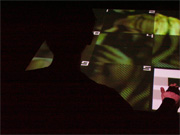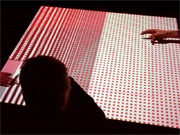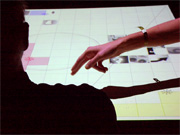- Concert: 8=8=Les Joueurs de cartes
- Concept + Design: Nao, TM, JankenPopp, abstractmachine
- Festival: Scopitone
- Dates: 30 June 2006 + 1 July 2006
- Times: 11h30 & 17h (2 performances per day)
- Location: Atelier & Chantiers de Nantes (+info)
- Direct link: 8=8
- Video: 8=8 demo @ YouTube
We will performing the _8=8=Les_joueurs_decartes again, this time at the Scopitone festival in Nantes, France (don’t mind the horrid website design, they are actually really nice people). Unfortunately we will be performing in the afternoon (*update: performances at 11h30 and 17h on both days), rather than in the evening with the truly hep cats such as Coldcut, Matmos, or Birdy Nam Nam. I guess we’re still not sexy enough to play in the big sandbox.
Here is the official 8=8 press kit, along with some photos Colette Stanley took of the concert last October in Marseille:
- // 8=8=Les joueurs de cartes=The Card Players
- // 8=8=TM=Nao=Jankenpopp=Abstractmachine
- // 8=8=Thomas Michalak=Naoyuki Tanaka=Pierre-Erick Lefebvre=Douglas Edric Stanley
// 8=8=Concert=Performance=Demo
8=8 is a group of 4 programmers = 4 composers = 4 VJs = 4 musicians = 4 artists. All four bring their own programming, visual and musical sensibilities to a collective instrument, the Abstract Machine Hypertable. By moving one’s hands over the surface of the Hypertable, images and sounds are generated, creating a unique opportunity for musical improvisation. 8=8 uses the Hypertable to perform singular programs/instruments in a concert=performance=demo context.
// 8=8=Program
All programs are generated by the members of 8=8. There is no distinction between performer = musician = artist = programmer. All members have been exploring computer programming as an artistic medium for several years, notably through collaborative research at the Atelier Hypermedia.
// 8=8=Instrument
Although the Hypertable was originally designed as an interface for algorithmic cinema, 8=8 quickly discovered its musical potential as an instrument. Each program is essentially an entire visual and musical software/instrument in and of itself. Some of the programs allow for direct manipulation of pre-recorded samples, other instruments generate sounds on-the-fly, while still others combine these two notions with the idea of composition taking place in real-time, on the surface of the table, and in front of the public. Some compositions=programs=instruments are visually baroque, others on the contary are minimalist. All work off the principle that image+interaction pilots the sound generation.
// 8=8=Big_Daddy
While the performers are free to improvise within each of the programs, there is also a Central Processing Unit, known in 8=8 speak as Big Daddy. Big Daddy’s role is to organize the flow of the concert itself. It switches the table from its public installation mode (see below) into its concert/performance mode, and controls the sequence of programs. There are over 10 programs currently installed in the 8=8 arsenal, and as more programs can be added before each concert, Big Daddy’s role is equally to keep things organised and working smoothly. Big Daddy is, in effect, 8=8’s stage manager.
// 8=8=Rock+Roll
Nothing could be less exciting than watching a solemn performer sitting on an empty stage behind a laptop. Although interesting attempts have been made recently to jazz up the experience — we’re thinking of recent performances by Golan Levin & Zachary Lieberman, or the excellent TopLap — ultimately 8=8 has found that the entire configuration of Raised Stage + Subservient Public has to be thrown out in order to create a more intimate and engaging relationship with the public. The public actually sits around the table, with the performers, or stands up looking down on the table (the table is only 30 cm high for this reason). Interesting configurations can also be envisioned, for example in situations where the public can look down from a balcony, depending of course on the local architecture.
// 8=8=Public
Before the concert, Big_Daddy informs the public of the time remaining before the concert with a countdown timer displayed on the surface of the table. All concerts start on-time, accurate down to the second. A small interactive program runs on the surface of the table as well, allowing visitors to explore — in a minimal/limited fashion — the technology that will run the concert. Although the original intent of this program was primarily pedagogical (= this is how the system works), as it turns out the public really takes to this little program. Consequently, two modes can be imagined for the Abstract Machine Hypertable: A) as reactive installation, B) as a concert platform. As such, several performances can be organized, with the interactive/public mode converting over to concert/performance mode at a pre-determined time. These decisions are of course dependent on local opportunities and the variable temperament of the 8=8 group.






